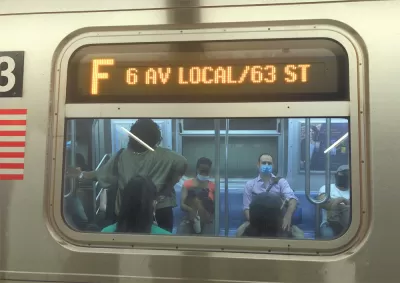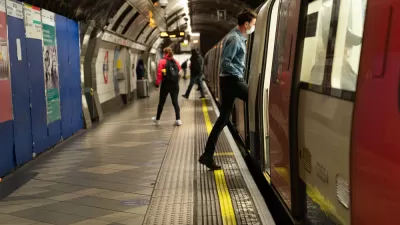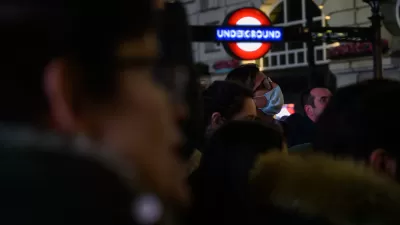Recent analysis by TransitCenter quantifies the effects of the pandemic for the 150 largest U.S. transit systems.

TransitCenter presents data on the operations of public transit agencies during the COVID-19 pandemic—finding ongoing evidence of sweeping service reductions in almost every part of the country. Some cuts have been deeper than others, however, as transit agencies have delt with declining ridership (and the farebox revenues that come along with riders)—whether due to disrupted commute patterns or stay-at-home orders—and the public health risks posed to operators.
TransitCenter analyzed data from National Transit Database monthly data to provide the following summariy of the state of public transit in the United States at the conclusion of the pandemic year, 2020.
Of the 150 largest transit agencies, about one in six were providing less than 75% of their pre-pandemic service hours in December 2020. Meanwhile, nearly a quarter were running between 90 and 100% of pre-pandemic service, and 27 agencies were running more service than they were before the pandemic as part of providing socially distanced transit.
Among those aggregated figures, TransitCenter also notes big differences between the largest agencies. While some have been able to restore most of the service cut in spring of 2020, some have struggled to restore service. The San Francisco Municipal Transportation Agency (SFMTA) has dealt with technical challenges restoring Muni Metro service, for example. The Maryland Transit Administration was operating just 66 percent of its pre-pandemic capacity in December, according to the article (after stopping short of cutting service even deeper). At the other end of the spectrum, Phoenix is operating more transit service than before the pandemic.
Breaking down the data by mode, TransitCenter reports that service has been cut most deeply for commuter rail—indicating one potential outcome of the long-term effects of fiscal stress and migration patterns of the pandemic.
FULL STORY: How Much Service Are Transit Agencies Running During the Pandemic?

Planetizen Federal Action Tracker
A weekly monitor of how Trump’s orders and actions are impacting planners and planning in America.

Congressman Proposes Bill to Rename DC Metro “Trump Train”
The Make Autorail Great Again Act would withhold federal funding to the system until the Washington Metropolitan Area Transit Authority (WMATA), rebrands as the Washington Metropolitan Authority for Greater Access (WMAGA).

The Simple Legislative Tool Transforming Vacant Downtowns
In California, Michigan and Georgia, an easy win is bringing dollars — and delight — back to city centers.

The States Losing Rural Delivery Rooms at an Alarming Pace
In some states, as few as 9% of rural hospitals still deliver babies. As a result, rising pre-term births, no adequate pre-term care and "harrowing" close calls are a growing reality.

The Small South Asian Republic Going all in on EVs
Thanks to one simple policy change less than five years ago, 65% of new cars in this Himalayan country are now electric.

DC Backpedals on Bike Lane Protection, Swaps Barriers for Paint
Citing aesthetic concerns, the city is removing the concrete barriers and flexposts that once separated Arizona Avenue cyclists from motor vehicles.
Urban Design for Planners 1: Software Tools
This six-course series explores essential urban design concepts using open source software and equips planners with the tools they need to participate fully in the urban design process.
Planning for Universal Design
Learn the tools for implementing Universal Design in planning regulations.
Smith Gee Studio
City of Charlotte
City of Camden Redevelopment Agency
City of Astoria
Transportation Research & Education Center (TREC) at Portland State University
US High Speed Rail Association
City of Camden Redevelopment Agency
Municipality of Princeton (NJ)





























